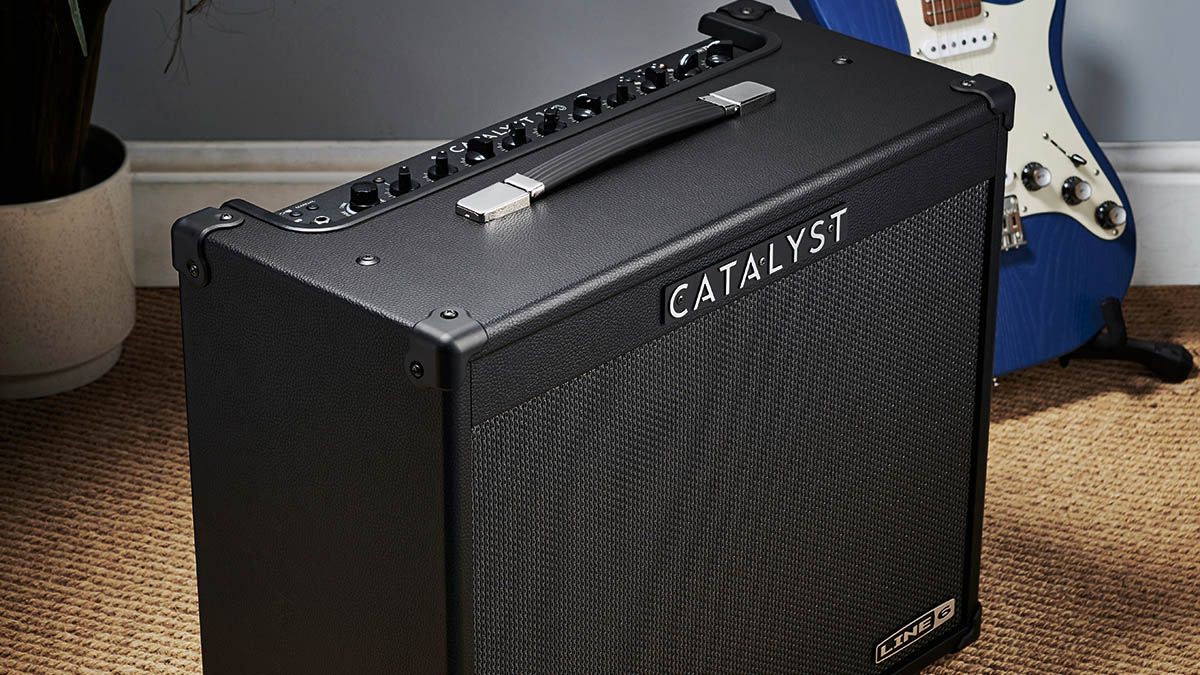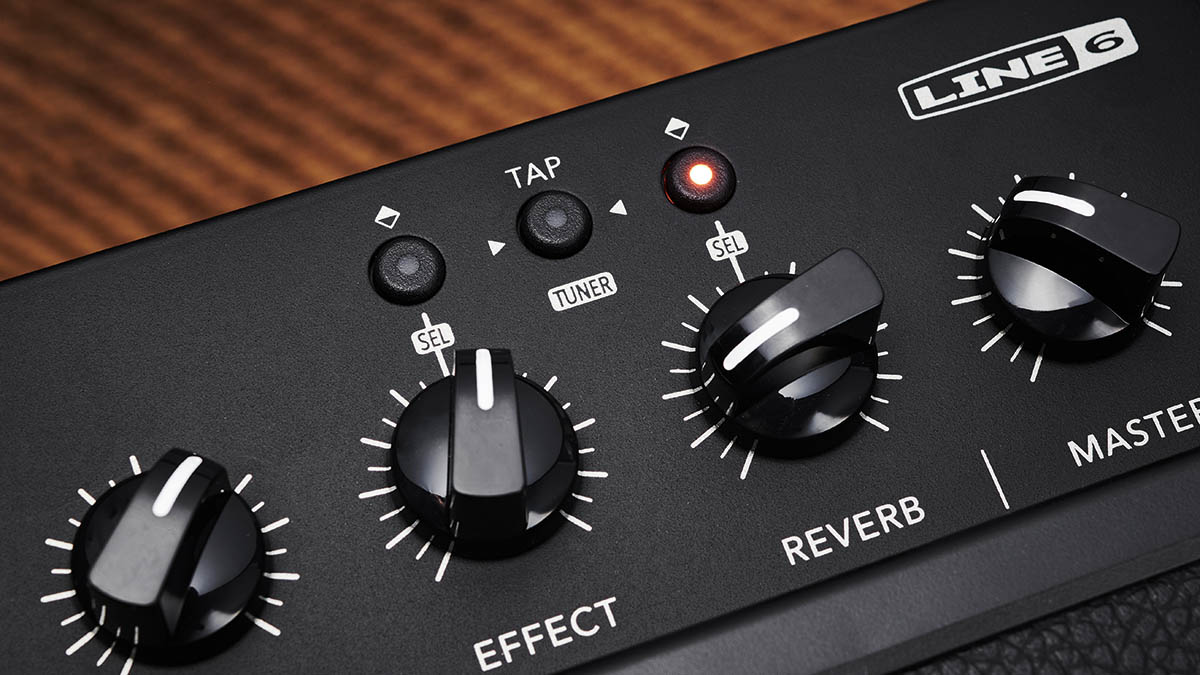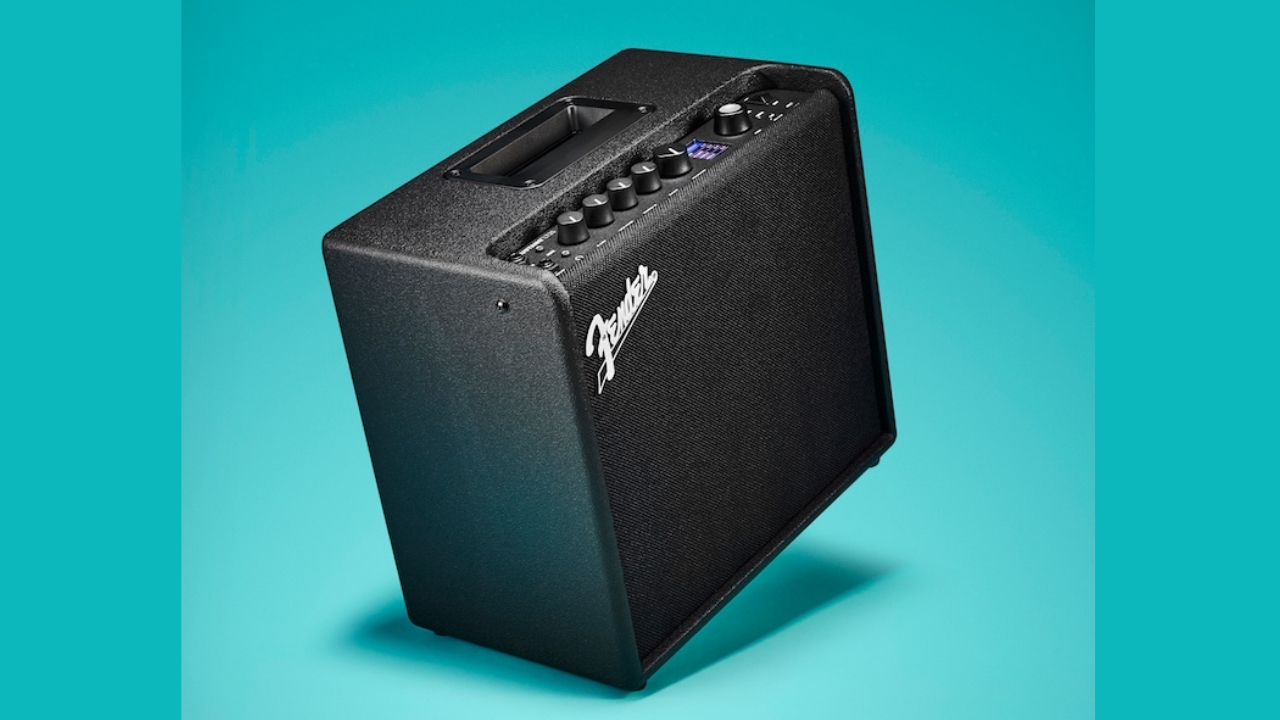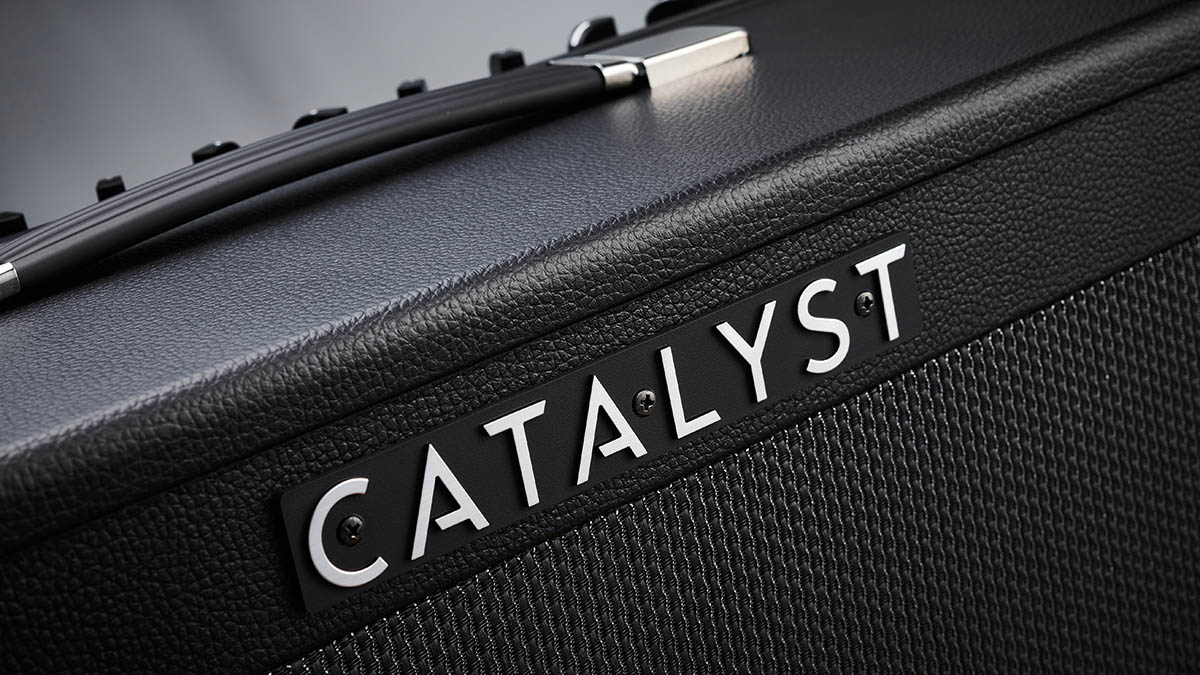MusicRadar Verdict
Attractive price, attractive design, a great range of tones and practical array of features makes the Catalyst another excellent 21st-century guitar amplifier from a company that has done so much to shape 21st-century guitar tone.
Pros
- +
Excellent range of sounds and functions.
- +
Solid build and it looks cool, too.
- +
Competitively priced.
Cons
- -
Footswitch sold separately.
- -
No Bluetooth connectivity.
MusicRadar's got your back
Line 6 Catalyst 100: What is it?
That guitar amp and effects modelling are now ubiquitous are down in no small part to the innovations of Line 6. For a generation of players whose amplifier choice had hitherto been restricted to solid-state or tube amp, 1997 was a hinge moment in guitar history as the kidney-bean-shaped Line 6 POD unit opened the door to another world.
The original POD (POD 1.0) was not Line 6’s first amp modeller. That honour goes to the AxSys 212 amp, which arrived a year earlier. But it was the one to capture the imagination of guitar players the world over, offering 16 guitar amp types in an impossibly compact unit. Magic.
Line 6 performed the same trick a couple of years later, doubling the number of amplifiers on offer. The POD changed guitar culture in much the same way as another famous “Pod” would do upon its launch in 2001. You can draw a parallel between the Line 6 POD and the Apple iPod, in the sense that the functionality has migrated into other forms.
Our mp3s now reside on our smartphones. Our amp modellers can be found everywhere, from pocket-sized headphones units such as Fender’s Mustang Micro to rack-mounted units and similarly tooled-up floor units that offer more sounds than any one player might need – but, by virtue of having tones for all demographics, amp modelling positions itself as offering something for everyone.
Line 6’s latest digital modelling amp range looks to do something similar. But it does so by taking things back to basics, offering a digitally augmented twist on the classic two-channel combo formula, and pricing the amplifiers for beginners, students, or anyone looking for a bargain amp with a heap of tones.
There are three amps in this new Catalyst series – the Catalyst 200 2x12, Catalyst 100 and Catalyst 60 1x12. While the latter looks a sure bet for domestic use, the Catalyst 100 has enough Class D power to make it a good option for the stage, too. Both the 100 and its larger 2x12 sibling have a balanced XLR output to allow you to send your signal to the desk when playing live.
Such as it is with this technologically disrupted hour, there are features galore here. First, though, it would be remiss not to comment on the appearance of the series. Line 6 might be pricing the Catalyst series for all but it has not spared the design nous. We love that grille cloth, the futurist typeface, and the matt-black vinyl looks durable and well applied.

There’s some heft to the 1x12 format. No bad thing. Inside the cabinet, you will find a 12” HC100 speaker – a Line 6 proprietary design with a large ceramic magnet. It’s not the done thing to throw review gear down the stairs to test its durability but one suspects this could survive a fall. The Catalyst should certainly withstand being loaded and unloaded into the back of a van. It looks and feels built to last.
When adjusting to the abundant features in the digital ecosystem, there is a danger that guitar players get bamboozled by everything that’s on offer. Line 6 recognises this, and has designed the control panel accordingly.
If you have ever used a modelling amp before, it should look very familiar. If you haven’t, the features are integrated into a panel that is really just like any amp save for a few more bells and whistles. Line 6’s design is so good the manual – or the “pilot’s guide” – might not be needed. Well, maybe just the once…

When you plug in, the first dial you are confronted with is a six-way rotary dial for cycling through Clean, Boutique, Chime, Crunch, Dynamic and Hi Gain amp voices. Above which there is a Manual button that you hold down to toggle between your presets mode and Manual mode where all the dials on the front panel are active.
Next, there are Boost and Gain controls, then Bass, Middle, Treble and Presence. All very familiar. Then there are Channel Volume, Effect, Reverb and Master dials. Channels can be switched via two buttons above the instrument jack on the front panel, and you can save six banks of channels for a total of 12 onboard presets. Six is the magic number: the Catalyst has six reverbs, six delays, six modulation effects and six pitch-shifting and filter effects.

Above the effects section, you’ll find a tap tempo button for the time-based effects that also access the tuner.
On the rear panel, there is an on/off switch, power scaling that allows you to dial down to half-power, 1/2W or an option to mute the speaker entirely. There’s a USB port that will come in handy when deep-editing presets via the app, and a MIDI port for controlling preset changes and so forth.
There is an input for the FS2 footswitch, sold separately, an aux in, headphones out, and an effects loop that can be switched to send the signal from an external pedalboard or amp modeller straight to the Catalyst’s power amp, or to be run as a regular effects loop, and finally there is the XLR with ground lift.

Line 6 Catalyst 100: Performance and verdict
As ever with digital amplifiers, there is a lot more than meets the eye, especially once you factor in the many editing possibilities from the Catalyst Edit app (available for Windows, Mac, iOS and Android). But that need not be intimidating. The Catalyst is intuitive enough that you will be editing and saving down sounds in no time – particularly with the app, which really makes light work of editing sounds, allowing players the opportunity to take a granular approach to designing their sounds.
There is also the option of sourcing sounds from the Line 6 user community via the CustomTone preset and impulse response marketplace. Straight out of the box, however, the amp has plenty to be getting started with. Its six amp models covering a lot of ground.

• Fender Mustang LT25
Modelling tones, onboard effects and USB connectivity for recording your playing, the Mustang makes for a great value practice amp.
• Positive Grid Spark 40
The Positive Grid Spark 40 might just be the ultimate at-home amp. The tones are great, and the smart tech is indeed smart. Auto Chord and Smart Jam are incredible practice and learning tools, and a lot of fun, too.
• Boss Katana 100/212 Combo
the Katana range is a great choice for beginners and experienced players alike, especially old-school valve amp diehards waiting for a reliable, practical and above all affordable digital alternative to the glass bottle.
Clean is exactly that. That’s where the headroom is at, making use of that ceramic speaker’s response. Boutique leans into that American high-end tube amp sound, while Chime might make you think Vox et al. Crunch has a distinctly British accent while Dynamic is what Line 6 describes as “Highly touch-responsive, mid-gain tone”. Hi Gain is for your contemporary metal amps, tight bottom end, and a domesticated short-cut to having a Mesa/Boogie-esque Dual Rectifier tone.
But while these voicings call to mind classic amps, it is worth noting they are all original amp voicings rather than an explicit model of another brand. Which voicing tickles your fancy is a matter of taste. There’s enough dirt to split the atom on the Hi Gain voicing. The Dynamic really does behave much like a tube amp does, responsive to your playing. The Boutique setting just sounds so… Well, it sounds premium. That you can customise the boost function to complement each of the amp types is the icing on the cherry on the top of the cake.
The effects are similarly realistic and place a sort of greatest hits pedalboard at your disposal, with musical delays, typically three-dimensional and lush chorusing. This is a 21st-century product but there are some lovely old-school sounds to be had from an echo voiced after an Echoplex, a Shin-ei Uni-Vibe emulation, and Leslie rotating speaker effect, the latter two very useful for adding a bit of Hendrix-esque psychedelia to your sounds.
To really get the best out of these effects, it is best to edit via the app, where the control over them is more comprehensive. Again, the seamlessness of the connection makes this painful, and once you bank some sounds down the convenience is something to be valued.
Altogether, the Catalyst is yet another amplifier from Line 6 whose role is to use technology to present players with options and then to get out of the way and let them play.
MusicRadar verdict: Attractive price, attractive design, a great range of tones and practical array of features makes the Catalyst another excellent 21st-century guitar amplifier from a company that has done so much to shape 21st-century guitar tone.
Line 6 Catalyst 100: The web says
“While Line 6’s Catalyst is familiar and straightforward to operate, there’s just enough under the hood to satisfy those who like to tweak things. Consequently, it’s great fun to use, despite a few relatively minor niggles, which could easily be corrected via future firmware upgrades.
“That said, the Catalyst’s sounds and effects are inspiring, pushing you to play better to get the most from them, while the range prices are very affordable – the Catalyst 60 is likely to sell on the street for under the magic $300/£250 mark, making it a great ‘first proper amp’ choice.”
Guitarist
Line 6 Catalyst 100: Hands-on demos
Line 6
Guitar Center
PMTVUK
Riffs, Beards & Gear
Andertons
Line 6 Catalyst 100: Specifications
- ORIGIN: Malaysia
- TYPE: Digital modelling preamp, solid-state power stage
- OUTPUT: 100W into 4 ohms, switchable to half power,
0.5W and mute - VALVES: None
- DIMENSIONS: 487 (h) x
564 (w) x 262mm (d) - WEIGHT (kg/lb): 14.5/32
- CABINET: Particle board
- LOUDSPEAKERS: 1x Line 6 Catalyst HC100 12”
- CHANNELS: 12x presets arranged as 6x banks of 2x A/B patches
- CONTROLS: Channel A/B/Manual switches, amp voice/effects selector, boost level, boost select, gain, bass, mid, treble, presence, channel volume, effects level, reverb level, master volume. Effects/reverb/tap tempo switches, output power switch, fx loop mode switch, ground lift
- ADDITIONAL FEATURES: Balanced XLR line out with ground lift, series effects loop, USB ‘B’ connector, MIDI in, aux in, headphones output. Firmware updates via USB port on bottom of chassis
- FOOTSWITCH: Optional LFS2 2-button footswitch controls channel A/B switching and effects on/off
- OPTIONS: LFS2 2-button footswitch $39/£44
- RANGE OPTIONS: Catalyst 60 (£342) 2x12 Catalyst 200 (£603)
- CONTACT: Line 6
MusicRadar is the number one website for music-makers of all kinds, be they guitarists, drummers, keyboard players, DJs or producers...
- GEAR: We help musicians find the best gear with top-ranking gear round-ups and high-quality, authoritative reviews by a wide team of highly experienced experts.
- TIPS: We also provide tuition, from bite-sized tips to advanced work-outs and guidance from recognised musicians and stars.
- STARS: We talk to musicians and stars about their creative processes, and the nuts and bolts of their gear and technique. We give fans an insight into the craft of music-making that no other music website can.
“Its mission is simple: unleash the power of any amplifier or line-level source without compromise”: Two Notes promises a “watershed” in tube amp control with the Torpedo Reload II
“I’m looking forward to breaking it in on stage”: Mustard will be headlining at Coachella tonight with a very exclusive Native Instruments Maschine MK3, and there’s custom yellow Kontrol S49 MIDI keyboard, too
“The thing from the agency said, ‘We want a piece of music that is inspiring, universal, blah-blah, da-da-da...' and at the bottom it said 'and it must be 3 & 1/4 seconds long’“: Brian Eno’s Windows 95 start-up sound added to the US Library of Congress











